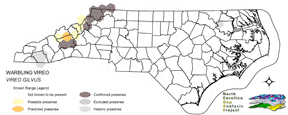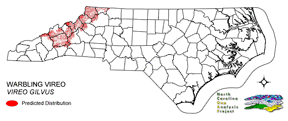
| Taxa: |
| Order: |
| Family: |
| Aves |
| Passeriformes |
| Vireonidae |
| NatureServe Global Rank: |
| NatureServe State (NC) Rank: |
| G5 |
| S2B,SZN |
| Federal Status: |
| NC State Status: |
| --- |
| SR |


| Land Unit |
| US Fish & Wildlife Service |
| US Forest Service |
| US National Park Service |
| US Department of Defense |
| NC State Parks |
| NC University System |
| NC Wildlife Res. Com. |
| NC Forest Service |
| NC Div. of Coastal Mgmt. |
| Local Governments |
| Non-Governmental Org. |
| Other Public Lands |
| Private Lands |
| GAP Status 1-2 |
| All Protected Lands |
| Statewide |
| Hectares |
| 0.00 |
| 49,832.55 |
| 0.00 |
| 7,714.71 |
| 385.11 |
| 37.53 |
| 536.85 |
| 308.70 |
| 0.00 |
| 2,929.59 |
| 2,006.55 |
| 24.30 |
| 241,216.11 |
| 12,314.88 |
| 63,603.00 |
| 304,992.00 |
| Acres |
| 0.00 |
| 123,138.89 |
| 0.00 |
| 19,063.46 |
| 951.63 |
| 92.74 |
| 1,326.58 |
| 762.81 |
| 0.00 |
| 7,239.17 |
| 4,958.29 |
| 60.05 |
| 596,057.87 |
| 30,430.73 |
| 157,166.41 |
| 753,651.50 |
| % of Dist. on |
| Prot. Lands |
| 0.0 % |
| 78.3 % |
| 0.0 % |
| 12.1 % |
| 0.6 % |
| < 0.1 % |
| 0.8 % |
| 0.5 % |
| 0.0 % |
| 2.9 % |
| 2.9 % |
| 0.0 % |
| 0.0 % |
| 19.4 % |
| ----- |
| ----- |
| % of Dist. on |
| All Lands |
| 0.0 % |
| 16.3 % |
| 0.0 % |
| 2.5 % |
| 0.1 % |
| < 0.1 % |
| 0.2 % |
| 0.1 % |
| 0.0 % |
| 1.0 % |
| 0.7 % |
| < 0.1 % |
| 79.1 % |
| 4.0 % |
| ----- |
| ----- |
|
Restricted to mountain region although occasional records exist in Piedmont (Pearson 1959). Breeds in open mature deciduous and mixed woodlands, riparian forests, and thickets (Ehrlich et al. 1988). Does not occur in forests but rather where a river or stream is lined by hardwoods (Hamel 1992) such as willow, alder (Farrand 1983), sycamore, and balm- of-Gilead (Simpson 1992). Nest placed at far end of branch in canopy of hardwood trees lying alongside a stream or river (Ehrlich et al. 1988, Hamel 1992). NATURE SERVE GLOBAL HABITAT COMMENTS: Open deciduous and mixed deciduous-coniferous woodland, riparian forest and thickets, pine-oak association, orchards, and parks; in migration and winter in a wide variety of forest, woodland and scrub habitats (AOU 1983). In winter seems to prefer light woodland and savanna groves (Stiles and Skutch 1989). Usually nests at end of branch in a deciduous tree, 9-18 m above ground, or 1-3.5 m above ground, in shrub or orchard tree (Terres 1980). |
| Code | Name | Description | NC Natural Heritage Program Equivalent |
| 230 | Piedmont Mesic Forest | American Beech - Red Oak - White Oak Forests. | Mesic Mixed Hardwood |
| 384 | Piedmont/Mountain Mixed Bottomland Hardwood Forests | Includes temporarily to seasonally forests dominated by hardwood species. Hardwoods include sweetgum, red maple, sycamore which co-occur in a mosaic of bottomland and levee positions. Includes alluvial hardwood forests in the mountains. Hemlock and white pine may occur as inclusions, but are generally mapped separately. | Piedmont/Mountain Alluvial Forest, Piedmont/Mountain Levee Forest |
| 383 | Piedmont Mixed Successional Forest | Generally loblolly mixed with successional hardwoods. Sweetgum, tulip poplar and red maple are common co-dominants in these successional forests. | No equivalent |
| 228 | Piedmont Dry-Mesic Oak and Hardwood Forests | Primarily oak dominated forests, white oak is often dominant, with co-dominants including . Also represented by sweetgum and tulip poplar dominated forests. | Dry Mesic Oak Hickory Forest, Basic Oak Hickory Forest, Dry Oak Hickory Forest |
| 382 | Dry Mesic Oak Pine Forests | Mixed forests of the coastal plain and piedmont. Includes loblolly pine with white, southern red and/or post oak and loblolly with water oak. On basic sites of the piedmont, eastern red cedar may co-occur with post, black, and blackjack oaks. | Dry Mesic Oak Hickory Forest, Xeric Hard Pan Forest, Chestnut Oak Forest, Dry Mesic Oak Hickory Forest, Dry Oak Hickory Forest |
| 517 | Hemlock Floodplain Forest | Alluvial forest with hemlock and/or white pine in mountains and western piedmont. Hydrology is generally temporarily to seasonally flooded. | Canada Hemlock Forest |
| 525 | Appalachian Oak Forest | A variety of oak forest types including Black, White, Scarlet Oaks in dry to mesic situations. Includes forests historically co-dominated by American Chestnut. | High Elevation Red Oak Forest, Montane White Oak Forest |
| 526 | Appalachian Cove Forest | Mixed Mesophytic forests of the mountains. Includes tuliptree, basswood, yellow buckeye and surgar maple. This class is mapped to include cove forests dominated or co-dominated by hemlock. | Rich Cove Forest, Acidic Cove Forest |
| 527 | Appalachian Hemlock | Upland hemlock forests of the moutains region. Vary from side slopes to steep slope positions. | Canada Hemlock Forest |
|
Barlow, J. C. 1980. Patterns of ecological interactions among migrant and resident vireos on the wintering grounds. Pages 79-107 in B80KEA02NA.
Johnson, N. K., R. M. Zink, and J. A. Marten. 1988. Genetic evidence for relationships in the avian family Vireonidae. Condor 90:428-445. Hagan, J.M., III, and D.W. Johnston, editors. 1992. Ecology and conservation of neotropical migrant landbirds. Smithsonian Institution Press, Washington, D.C. xiii + 609 pp. Hamel, P. B. 1992. The land manager's guide to the birds of the south. The Nature Conservancy, Chapel Hill, North Carolina. 367 pp + several appendices. Simpson MB Jr. 1992. Birds of the Blue Ridge Mountains. Chapel Hill and London: University of North Carolina Press. Murray, B. W., et al. 1994. The use of cytochrome B sequence variation in estimation of phylogeny in the Vireonidae. Condor 96:1037-1054. Sauer, J.R., and S. Droege. 1992. Geographical patterns in population trends of neotropical migrants in North America. Pages 26-42 in J.M. Hagan III and D.W. Johnston, editors. Ecology and conservation of neotropical migrant landbirds. Smithsonian Institu Bureau of Land Management. Life History Summaries. Pearson, T.G. 1959. Birds of North Carolina. Raleigh, NC: Bynum Printing Company. Harrison, C. 1978. A field guide to the nests, eggs and nestlings of North American birds. Collins, Cleveland, Ohio. Keast, A., and E. S. Morton. 1980. Migrant birds in the Neotropics; ecology, distribution, and conservation. Smithsonian Inst. Press, Washington, D.C. Terres, J.K. 1980. The Audubon Society encyclopedia of North American birds. Alfred A. Knopf, New York. American Ornithologists' Union (AOU), Committee on Classification and Nomenclature. 1983. Check-list of North American Birds. Sixth Edition. American Ornithologists' Union, Allen Press, Inc., Lawrence, Kansas. Farrand, J., editor. 1983. Audubon Society master guide to birding. Alfred A. Knopf, New York. 3 vols., 1244 pp. Ehrlich, P.R., D.S. Dobkin, and D. Wheye. 1988. The birder's handbook:a field guide to the natural history of North American birds. Simon and Shuster, Inc., New York. xxx + 785 pp. Stiles, F.G., and A.F. Skutch. 1989. A guide to the birds of Costa Rica. Comstock Publ. Associates, Cornell University Press, Ithaca, New York. 511 pp. Droege, S., and J.R. Sauer. 1990. North American Breeding Bird Survey, annual summary, 1989. U.S. Fish and Wildlife Service, Biological Report 90(8). 22 pp. Sibley, C.G., and B.L. Monroe. 1990. Distribution and taxonomy of birds of the world. Yale University Press, New Haven, Connecticut. xxiv + 1111 pp. |
For more information please contact them at:
NC-GAP Analysis Project
Dept. of Zoology, NCSU
Campus Box 7617
Raleigh, NC 27695-7617
(919) 513-2853
www.basic.ncsu.edu/ncgap